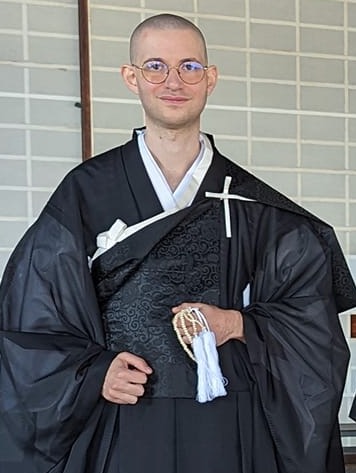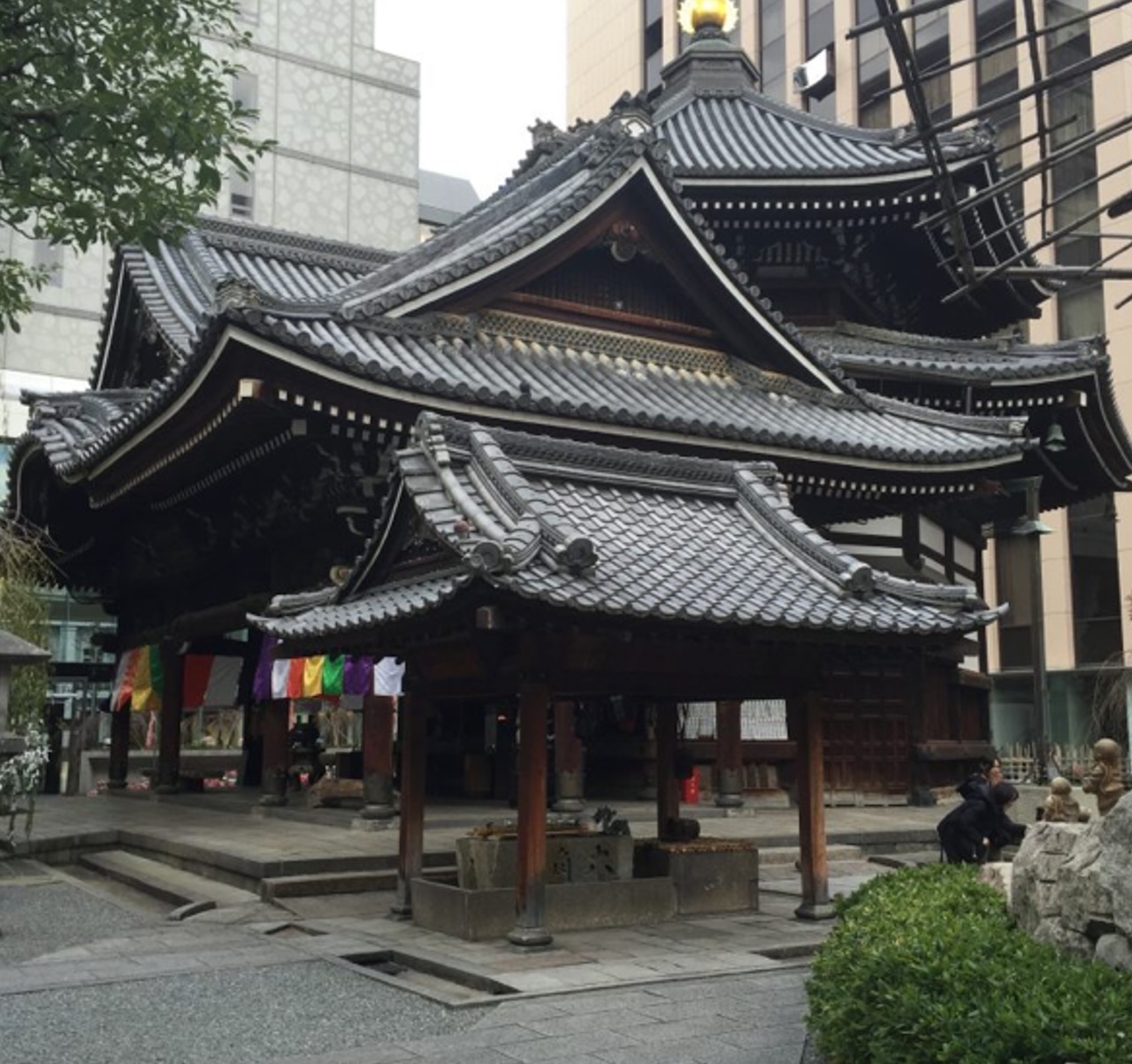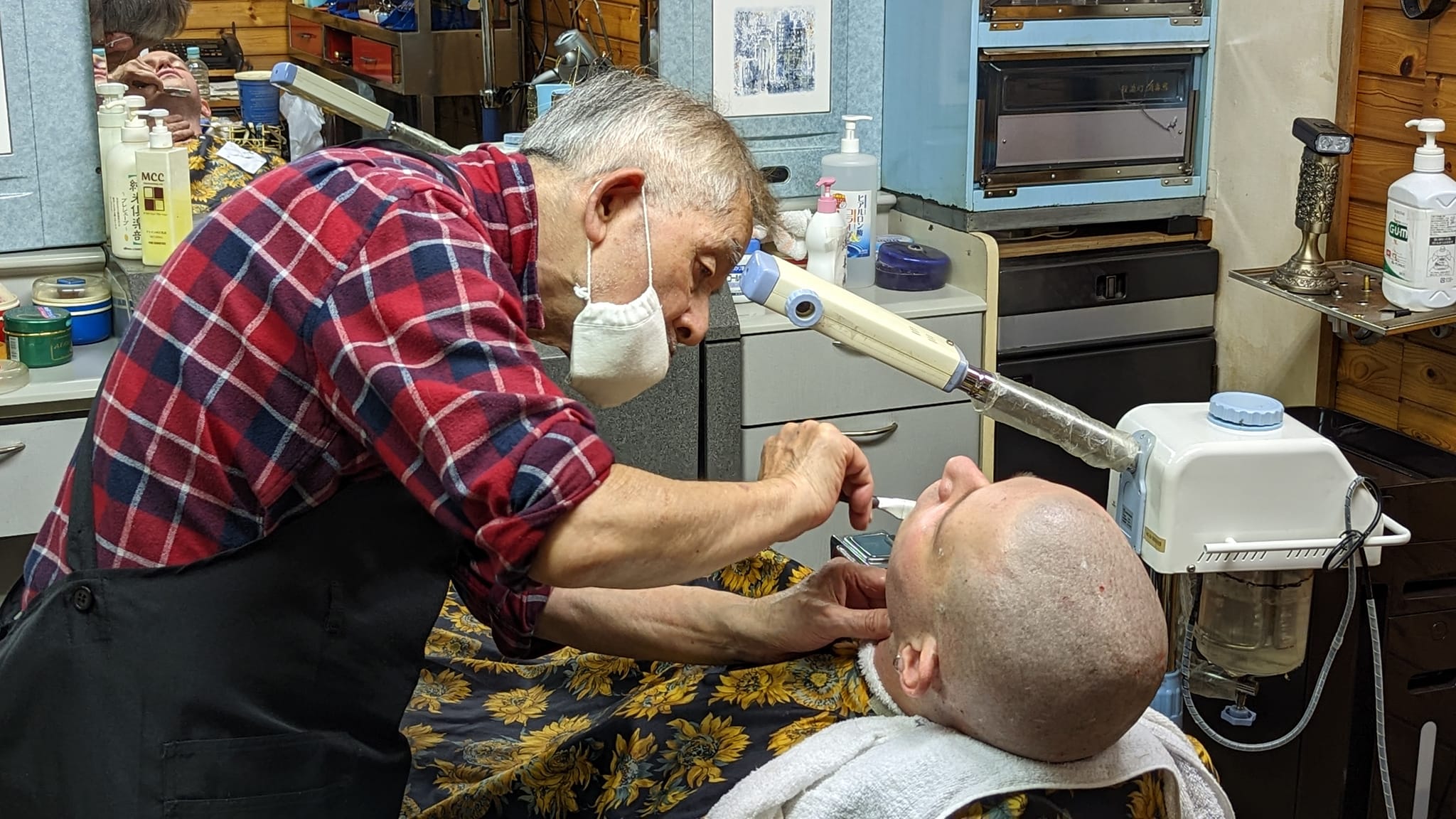
By Gregory Thomas
Receiving ordination from Higashi Honganji was an important step, both for my personnel growth and to help me share the Dharma with people in France.
On a personal level, becoming ordained is an expression of my commitment to Jodo Shinshu and the teachings of Shinran Shonin. It pushes me to study and practice more than ever. It’s a natural outcome of my studies over the past ten years.
I must have read more than a hundred books on Buddhism, especially Jodo Shinshu. I studied Shinran Shonin’s writings, and the writings of modern Shinshu thinkers, such as Manshi Kiyozawa, Daiei Kaneko, and Ryojin Soga. I also read much on Shinshu traditions, Higashi Honganji history and Buddhist essays in academic journals.
In 2018, I traveled from France to Kyoto, Japan, to study at a Japanese language school for six months. At that time, my priority was studying Japanese, but I also wanted to meet Jodo Shinshu teachers. By then, I had studied Jodo Shinshu for almost five years. I already had thoughts about someday becoming ordained.
Higashi Honganji’s International Department introduced me to Dr. Michael Conway, who is an American and a Shinshu studies professor at Otani University. Conway-sensei allowed me to participate in study groups focused on Soga-sensei’s writings and Shinran Shonin’s “wasan” (hymns on the Pure Land). He also helped me participate in “kikyoshiki,” a ceremony in which I received a Buddhist name. After I returned to France, Conway-sensei introduced me to Bishop Noriaki Ito, the bishop of Higashi Honganji’s North America District, who in turn, introduced me to other ministers in the United States.
Because I had been studying alone in France, where there are no Higashi Honganji temples, I didn’t know much about chanting and rituals. Fortunately thanks to Zoom, I was able to start daily chanting sessions with Rev. Ryoko Osa of the Berkeley Higashi Honganji temple in California. I learned about “Shoshinge” and the “mitsuyuri” style of chanting style. We also chanted Amidakyo (Smaller Infinite Life Sutra), as well as other chants. After a few months, Rev. Osa urged me to acquire an official chanting book so that we could eventually chant all of Shinran’s wasans. To this day, we continue to chant together almost daily.
I also enrolled in the Buddhist Churches of America’s Jodo Shinshu correspondence course, which took two years to complete, providing me with a good basic foundation for understanding Jodo Shinshu.
At the beginning of 2022, I and another student, Gary Link, who also was interested in becoming ordained, met with Bishop Ito to discuss our goals. Bishop Ito asked us to write a paper explaining our motivations and plans. After our papers were reviewed, we were given the go-ahead to start training for ordination.
Training consisted of eight online sessions with Rev. Tomoyuki Hasegawa, who is based in Los Angeles. He taught us more in-depth the essential chants in Jodo Shinshu. When we were ready, Bishop Ito conducted a chanting test. Passing meant I was eligible to attend the “tokudo” ordination ceremony in Kyoto.
“Tokudo” is a first level ordination, which allows a person to participate in rituals and ceremonies under the supervision of a fully ordained minister. Full ordination is called “kyoshi,” which requires much more training, study and experience.
Instead of being a hindrance, studying during the pandemic was particularly beneficial for me because, living in France far from teachers and temples, I already was isolated and studying remotely. New technology such as Zoom allowed me to connect with teachers, virtually attend study sessions and listen to lectures. It allowed me to participate in daily chanting, which really grounded me during the pandemic.
In preparing for the tokudo ordination ceremony, Rev. Hasegawa made the necessary arrangements and also escorted Gary and me to Japan. He ordered the robes, Buddhist beads, and other things we needed and translated all documents into English. He also found a barber in Kyoto next to the headquarters temple for shaving our heads the day before the ceremony.
He also took us to visit historical places in Kyoto related to Shinran. For example, we visited Shoren-in temple, where Shinran was ordained when he was 9 years old. We also visited Rokkakudō temple, where Shinran made a pilgrimage after he left the monastery on Mt. Hiei.

In preparation for the ceremony, I first tried on my robes at a shop near the temple. When my wife saw me suddenly looking like a priest, she became very emotional and almost burst out in tears. She knew this was an important step in my life.
When it came time to shave my head, we went to a barber shop as planned, but it was closed. Fortunately, we found another one close by. The owner was an old gentleman, probably over 90 years old, who seemed to be shaking a lot. He was really happy because I was his first customer from France. I’ve kept my hair long since childhood, so seeing it shaved off and becoming bald was a shock for both my wife and me.

On the day of the ceremony, we put on our white under-robe, but not the black outer robe. That would come later. The ceremony took place at the headquarters temple in the Goei-dō, or “Founders Hall,” where a statue of Shinran sits in the center of the main altar. Our group, which included children as young as 9 years old (the same age as Shinran when he was ordained), rehearsed what we needed to do. We then went out of the hall, put on our black robes, and re-entered the large room.
All the doors of the hall were closed and it was very dark. The only light came from some candles. The atmosphere replicated what Shinran experienced when he was ordained at night. The ceremony consisted of a ritual that simulates having our heads shaved, recitations, bowing and chanting. Including rehearsal time, the whole experience lasted about three hours.
I remember one participant could not stand up after sitting “seiza” Japanese style on the floor with legs folded underneath one’s body. Staff assistants immediately came to help her. I also had trouble sitting seiza a long time, so the staff kindly provided a small chair for me.
With the doors closed, quietly sitting in a darkened Goei-dō in front of a statue of Shinran, I felt deeply moved. When the ceremony ended and the doors finally were opened wide, light suddenly filled the hall. I really felt like Amida’s light was shining on us. We put on more formal robes and participated in a service. It was over.
After the ceremony, my wife and I returned to our Airbnb. I had a strange feeling. I was ordained, but yet felt I was still, what Shinran called, “a foolish being” (Japanese: bonbu). Shinran also called himself “neither Monk nor Layman,” a phrase in which I can somewhat relate.
I realize I need to reconcile this new identity as a Shinshu minister in my daily life. Now that I was “ordained,” I need to become worthy of this title.
This was an important step in fulfilling my wish to share the Jodo Shinshu teachings with people in France. As a beginner with only tokudo, I’m limited in what I’m allowed to do. I look forward to sharing the teachings and studying with others in a more formal role, not just as a layperson. I have much more to learn.

I plan to continue studying the writings of Shinran Shonin, along with other notable teachers such as Kiyozawa and Soga. I recently started a study group focused on Shinran’s master text, Kyogyoshinsho.
My hope is to continue studying and eventually to receive full “kyoshi” ordination, and then, perhaps starting a small temple in France. Meanwhile, I’ll continue to lead a small online study group in French and try and help people learn about Jodo Shinshu.
–Gregory Thomas lives in a small village in the Jura Mountains, France.

